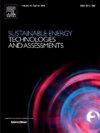A hybrid piezoelectric and electromagnetic energy harvester for harvesting fluid energy in a pipeline
IF 7.1
2区 工程技术
Q1 ENERGY & FUELS
Sustainable Energy Technologies and Assessments
Pub Date : 2025-07-20
DOI:10.1016/j.seta.2025.104469
引用次数: 0
Abstract
The power supply issue of flow velocity sensors is a major obstacle limiting their widespread application in fields such as remote environmental monitoring and industrial process control. This paper introduces a hybrid piezoelectric and electromagnetic energy harvester for harvesting fluid energy in a pipeline (F-HEH). F-HEH mainly comprises two parts: a self-powered module and a self-sensing module. Experimental results indicate that when the rotor is equipped with 15 blades and the PEH is connected in series, the F-HEH system achieves optimal output performance, with the maximum root mean square power reaching 124.3 mW. Following performance testing, F-HEH was demonstrated to enable hydrogen production through water electrolysis. By leveraging the inherent properties of F-HEH, an energy storage and utilization circuit can be constructed to provide a continuous power supply for lithium batteries. The coefficient of determination (R2) reaches 0.97494 when fitting the relationship between water flow speeds and corresponding voltage frequencies. This proves that F-HEH also has a self-sensing function. This research proposes an innovative approach for energy harvesting and flow velocity monitoring in fluid pipelines, contributing to the advancement of intelligent fluid monitoring systems.
一种用于在管道中收集流体能量的压电和电磁混合能量采集器
流速传感器的供电问题是限制其在远程环境监测和工业过程控制等领域广泛应用的主要障碍。介绍了一种用于管道流体能量采集的压电与电磁混合能量采集器(F-HEH)。F-HEH主要由自供电模块和自传感模块两部分组成。实验结果表明,当转子配置15片叶片,PEH串联时,F-HEH系统的输出性能最优,最大均方根功率达到124.3 mW。经过性能测试,F-HEH被证明可以通过水电解制氢。利用F-HEH的固有特性,可以构建能量存储和利用电路,为锂电池提供连续供电。拟合水流速度与相应电压频率的关系,决定系数(R2)达到0.97494。这证明了F-HEH也具有自感知功能。本研究提出了一种流体管道能量收集和流速监测的创新方法,为智能流体监测系统的发展做出了贡献。
本文章由计算机程序翻译,如有差异,请以英文原文为准。
求助全文
约1分钟内获得全文
求助全文
来源期刊

Sustainable Energy Technologies and Assessments
Energy-Renewable Energy, Sustainability and the Environment
CiteScore
12.70
自引率
12.50%
发文量
1091
期刊介绍:
Encouraging a transition to a sustainable energy future is imperative for our world. Technologies that enable this shift in various sectors like transportation, heating, and power systems are of utmost importance. Sustainable Energy Technologies and Assessments welcomes papers focusing on a range of aspects and levels of technological advancements in energy generation and utilization. The aim is to reduce the negative environmental impact associated with energy production and consumption, spanning from laboratory experiments to real-world applications in the commercial sector.
 求助内容:
求助内容: 应助结果提醒方式:
应助结果提醒方式:


